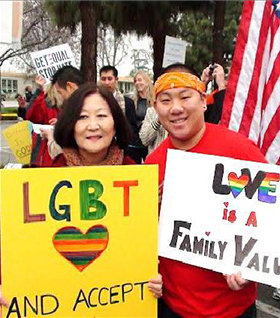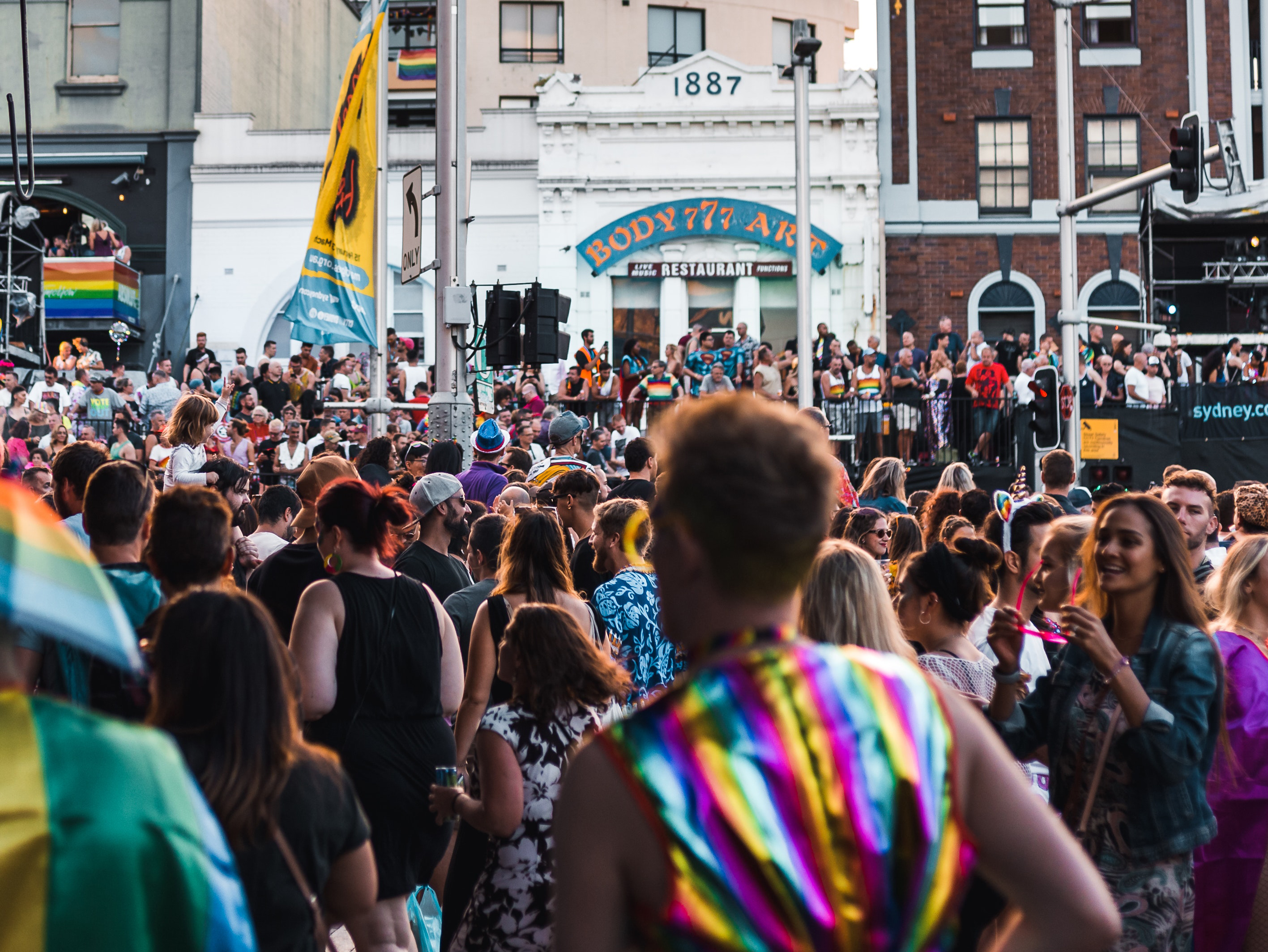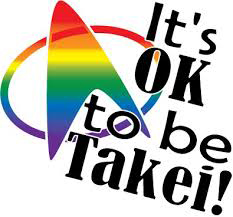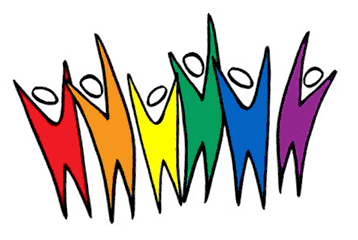This unit will introduce middle and high school students to LGBTQ civil rights with an emphasis on the struggle for marriage equality. They will learn about ideas, events, and individuals that influenced George Takei and his decision to come out as an advocate for LGBTQ rights and contextualize the fight for LGBTQ rights as an extension of the Civil Rights Movement. The unit will culminate in an essay assignment in which students will analyze how the discussed events, people, and ideas influenced the struggle for marriage equality.
We are beginning a unit on LGBTQ civil rights. Many of you may already be familiar with the LGBTQ community and the term civil rights. However, in this unit, we will discuss LGBTQ civil rights issues, focusing specifically on the issue of same-sex marriage.
- Show Slide 2: The LGBTQ Community & Marriage Equality
Explain to the students: We’ll be starting this unit on LGBTQ Civil Rights by learning about the LGBTQ community and the issue of same-sex marriage and marriage equality.
- Activity (Slide 3): What does LGBTQ mean? – Ask for 10 volunteers to participate in a warm-up game/activity. If 10 students do not volunteer, pick 10 students.
- Divide the 10 students into two teams of 5. Have one student from each team stand facing each other and have the rest of their team line up behind them.
- Place any object, such as a marker, whiteboard eraser, etc., at a distance equally between the two students who are facing each other.
- Premise of the activity: The teacher will write a letter from the LGBTQ acronym on the board (or simply say it out loud). Whoever grabs the object/marker/eraser first gets to say what it stands for. If that student gets it wrong, the other student gets a chance to guess.
- If the other student also does not get it correct, you can either give the other team a chance to work together to guess again or pose the question to the class.
- After going through the five letters, thank the students for participating and have them return to their seats.
- What does LGBTQ mean? (Slides 4-5):
As shown on the slides, go through the definition of each word that makes up the acronym.
- Lesbian: A woman who is emotionally, romantically or sexually attracted to other women.
- Gay: A person who is emotionally, romantically or sexually attracted to members of the same gender.
- Bisexual: A person emotionally, romantically or sexually attracted to more than one sex, gender or gender identity though not necessarily simultaneously, in the same way or to the same degree.
- Transgender: An umbrella term for people whose gender identity and/or expression is different from cultural expectations based on the sex they were assigned at birth. The alternative to transgender is cisgender.
- Explain that being transgendered (or trans) does not imply any specific sexual orientation. Accordingly, a transgender individual may identify as straight, gay, lesbian, bisexual, etc.
- Also, transgender is an adjective, to be used as: a transgender man, transgender woman, transgender individual. Using transgender as a noun is not only incorrect usage of the word but is considered offensive.
- Queer: An umbrella term for sexual and gender minorities. It was previously used as a slur but is now being reclaimed by some members of the LGBTQ community.
Activity 2: Marriage Equality (30 minutes)
- LGBTQ Rights – Marriage Equality (Slide 6): Obergefell v. Hodges (2015) made same-sex marriage legal throughout the country. Before then, 13 states banned same-sex marriage because there were no federal mandates that prevented states from doing so. Click for map http://www.governing.com/gov-data/same-sex-marriage-civil-unions-doma-laws-by-state.html.
- Marriage Equality – Supreme Court Ruling (Slides 7-8): These were a couple of the arguments that the Supreme Court Justices who voted in favor of legalizing same-sex marriage (the majority and winning position in this case) made to explain their decision.
- “The right of same-sex couples to marry that is part of the liberty promised by the Fourteenth Amendment is derived, too, from that Amendment’s guarantee of the equal protection of the laws.”
- “The fundamental liberties protected by the Fourteenth Amendment’s Due Process Clause extend to certain personal choices central to individual dignity and autonomy, including intimate choices defining personal identity and beliefs.”
- “In Loving the Court invalidated a prohibition on interracial marriage under both the Equal Protection Clause and the Due Process Clause. The Court first declared the prohibition invalid because of its unequal treatment of interracial couples… the prohibition offended central precepts of liberty: “To deny this fundamental freedom on so unsupportable a basis as the racial classifications embodied in these statutes, classifications so directly subversive of the principle of equality at the heart of the Fourteenth Amendment, is surely to deprive all the State’s citizens of liberty without due process of law.”
- “The reasons why marriage is a fundamental right became more clear and compelling from a full awareness and understanding of the hurt that resulted from laws barring interracial unions.”
- Marriage Equality – Dissenting Opinion (Slide 9): Explain to students that the Supreme Court justices who do not agree with a case’s decisions (those who vote no) explain their reasoning in the form of a dissenting opinion. These are some of the major arguments the justices had against legalizing same-sex marriage.
Dissenting Opinion – Justices who don’t agree with a ruling (those who vote no) explain their reasoning in the form of a dissenting opinion:
- “Although the policy arguments for extending marriage to same-sex couples may be compelling, the legal arguments for requiring such an extension are not. The fundamental right to marry does not include a right to make a State change its definition of marriage.”
- “…definition of marriage as the union of a man and a woman is no historical coincidence. Marriage did not come about as a result of a political movement, discovery, disease, war, religious doctrine, or any other moving force of world history... It arose in the nature of things to meet a vital need: ensuring that children are conceived by a mother and father committed to raising them in the stable conditions of a lifelong relationship.”
- Marriage as a Civil Right (Slide 10): Explain that Loving v. Virginia is the Court case that the Supreme Court rule was referencing when legalizing same-sex marriage.
- Loving v. Virginia addressed interracial marriage as a civil right.
- If interracial marriage is a civil right then same-sex marriage should also be a civil right.
- Both were discriminating individuals from marriage.
Activity 3: Loving (10 minutes)
- Loving (2016) Trailer (Slide 11)
- Before playing the trailer, pass out Lesson 1 Classwork Worksheet. Tell students to look over the questions as they’ll need to complete the Worksheet after/while watching the trailer. Play the trailer.
- Loving (2016) – Lesson 1 Classwork (Slides 12-13)
- After the trailer, continue to Slide 12 and give students a few minutes to answer the discussion questions.
- What is this movie about?
- Who are the individuals involved?
- What events influence their actions?
- What different ideas of love, marriage, and race are represented in the movie?
- While on Slide 12, ask students to share their answers. Encourage students to expand and explain answers for questions 3 and 4, as similar themes and narratives will come up again in the unit.
- Go over the answers on Slide 13 with the students, highlighting anything that the students’ answers did not cover.
- This movie is about the Supreme Court case Loving v. Virginia.
- The individuals are Richard Loving and Mildred Loving (née Jeter). They are husband and wife. One night, a cop arrests them because it is illegal for a white and “colored” couple to be married.
- Their arrest compels them to find a way to fight their conviction. They take their case to the Supreme Court.
- Characters in the movie have conflicting ideas about who is able to get married. Some believe that people of different races should not be able to marry, while others believe that people should have the choice to love and marry regardless of race.
Activity 4: Homework & Lesson 2 Preview (5 minutes)
- Pass out Lesson 1 Homework Worksheet to the class.
- Tell students: For homework, read “Representing LGBT Communities” on pages 9 and 10 of the George Takei story and answer the questions on the Lesson 1 Homework Worksheet (Slide 14).
- Lesson 2 Preview:
- Lesson 1 Review
- Defining Civil Rights
- 14th Amendment
- The Civil Rights Movement
- Introduction to Essay Assignment
Lesson 2: Civil Rights: The 14th Amendment & The Civil Rights Movement (Suggested Time: 75 minutes)
Materials:
- “George Takei: Leading Man” story
- “Final Assignment [Mild] Guidelines”
- “Final Assignment [Spicy] Guidelines”
- “Lesson 2 Quick Write Worksheet”
- “Lesson 2 [Mild] Tree Map”
- “Lesson 2 [Spicy] Tree Map”
- “Unit Slides: LGBTQ Civil Rights”
Materials Not Included:
- Projector
Activity 1: Quick Write Activity—Lesson 1 Homework Review (10 minutes)
- Tell students to pass up/turn in their homework assignment from Lesson 1. As they do this, pass out Lesson 2 Quick Write Worksheet. (Slide 16) Give students five minutes to answer the prompt “What is the main idea of ‘Representing LGBT Communities’?” with at least 2 examples from the text.
Then, ask students to share their answers:
- Ask for a student to summarize their answer and include one example from the text.
- Ask a different student to add to the summary of the main idea (if necessary) and provide another, different example from the text.
- Ask if there’s anything else anyone would want to add, either to the summary of the main idea or as an example they thought was especially important.
Before moving on to the next slide, restate the main idea, as identified by the students. Then explain that today’s lesson will focus on defining the acronym LGBTQ and give some background about the Civil Rights Movement.
Activity 2: Civil Rights & Marriage (15 minutes)
- What are Civil Rights? (Slide 17)
- Civil rights are the rights of individuals to receive equal treatment (and to be free from unfair treatment or discrimination based on certain characteristics, like race or disability).
- Civil rights are guaranteed by the Constitution or protected by legislation.
- Interracial Marriage as a Civil Right (Slides 18-19) As we discussed in Lesson 1, the film Loving is about interracial marriage and the Supreme Court case around that issue.
- Interracial marriage, also known as miscegenation, was illegal through state laws that had been in place since the US colonial era.
- They were meant to enforce segregation and maintain the “purity” of races.
- They were meant to enforce segregation and maintain the “purity” of races.
- These laws remained in place until 1967.
- Ask students if they know what segregation is. Pick someone to explain, helping them with the definition as necessary. Ask students:
- How does this relate to maintaining the “purity” of the races?
- Emphasize that this is racist, hateful thinking. It is this kind of thinking that is leading to the suffering of many non-white people in this country even today in many different ways (deportations & family separation, police violence/brutality, unequal pay across races and ethnicities, etc.).
Ask students if they think a law telling you who you can or cannot marry is fair. Why or why not? Pick on a few different students to share answers and to foster a discussion that covers different viewpoints or rationales.
- (Slide 19) In 1967, through Loving v. Virginia, the Supreme Court ruled to lift bans on interracial marriage: “Marriage is one of the ‘basic civil rights of man’… The Fourteenth Amendment requires that the freedom of choice to marry not be restricted by invidious racial discriminations. Under our Constitution, the freedom to marry, or not marry, a person of another race resides with the individual and cannot be infringed by the State.”
- While there had not been a federal law banning interracial marriage, individual states had laws that did.
- That “cannot be infringed by the State” is referring to those state laws that prohibited interracial marriage.
Activity 3: The 14th Amendment & Civil Rights (30 minutes)
- The 14th Amendment (Slides 20-22)
- Both Loving v. Virginia and Obergefell v. Hodges extended the freedom of choice to marry on the basis of the 14th Amendment.
- Actual Text:
“Section 1. All persons born or naturalized in the United States, and subject to the jurisdiction thereof, are citizens of the United States and of the State wherein they reside. No State shall make or enforce any law which shall abridge the privileges or immunities of citizens of the United States; nor shall any State deprive any person of life, liberty, or property, without due process of law; nor deny to any person within its jurisdiction the equal protection of the laws.”
- Ask students to identify parts of Section 1 that they think might point out the Equal Protection Clause and Due Process Clause before moving onto the next slide for a simplified definition of each clause.
- Equal Protection Clause & Due Process Clause (Slide 21):
- “No State shall make or enforce any law which shall abridge the privileges or immunities of citizens of the United States…”
Equal Protection Clause: “…nor deny to any person within its jurisdiction the equal protection of the laws”
→ all people must be treated equally by the law
Due Process Clause: “…nor shall any State deprive any person of life, liberty, or property, without due process of law”
→ the legal rights of a person to be treated equally and fairly
- The 14th Amendment was adopted in 1868 as one of three post-Civil War amendments that abolished slavery and established legal and civil rights for Black Americans.
- Since then, the Equal Protection Clause and Due Process Clause of Section 1 have been used in the decisions of landmark civil rights cases, such as:
- Brown v. Board of Education: ended state-sanctioned racial segregation
- Roe v. Wade: protected the right to abortion
- McDonald v. City of Chicago: defended gun possession rights
- It was also used by Congress to pass the Civil Rights Act of 1964, which further secured civil rights for many groups.
- Recap for students (while remaining on Slide 22):
- So, now we know that same-sex marriage and interracial marriage were legalized through the 14th Amendment because the Supreme Court saw freedom of choice in marriage as a civil right.
- Often, when we talk about civil rights, we talk about the Civil Rights Movement, which was a pivotal moment in this country’s history.
- Can anyone give a short explanation of what the Civil Rights Movement was?
- (affirm & correct student’s answer or call on others until receiving a correct response, as necessary)
- To gain an even deeper understanding of the significance of civil rights and the 14th Amendment, we’re going to go over the impact of the Movement.
- The Civil Rights Movement (Slide 23): Legislation from the Civil Rights Movement set the precedent for and secured rights for many different groups. Some legislation includes:
- Brown v. Board of Education (1954)—declared “separate but equal” schools as unconstitutional, a new stage in the Civil Rights Movement
- Civil Rights Act of 1964—outlaws discrimination based on race, color, sex, religion, or national origin
- Immigration and Nationality Act (1965)—reformed immigration laws to allow greater influx of non-white immigrants, which shows one way of how the Civil Rights Movement helped Asian Americans
- Voting Rights Act of 1965—aimed to overcome legal barriers at local and state levels that prevented African-Americans from exercising their right to vote
- Remaining on Slide 23, pause after going through the list and ask students to take two minutes to discuss with their shoulder partner how they think the Immigration & Nationality Act and the Voting Rights Act of 1965 relates to the area of civil rights. Call on a few students to share their answers with the class.
- The Civil Rights Movement (Slide 24): The precedent set by the Civil Rights Movement and the rights it secured illustrates how marriage equality is a civil rights issue:
- Loving v. Virginia (1967)—ruling: “The Fourteenth Amendment requires that the freedom of choice to marry not be restricted by invidious racial discriminations.”
- Equal Rights Amendment (1971)—sought to guarantee equal rights for all citizens regardless of their sex; passes in Congress but not ratified by states
- Li & Kennedy v. Oregon (2004)—case to determine whether denying same-sex couple the right to marriage violated Oregon Constitution
ruling: Multnomah County lacked the authority to issue marriage licenses to same-sex couples, and the licenses issued were void when issued
- Obergefell v. Hodges (2015)—ruling: “The Court held that the Due Process Clause of the Fourteenth Amendment guarantees the right to marry as one of the fundamental liberties it protects.”
- The Civil Rights Movement (Slide 25)
- Ask a student to read the quote by John Lewis: “I fought too hard and too long against discrimination based on race and color not to stand up and speak up against discrimination against our gay and lesbian brothers and sisters. I see the right to marriage as a civil rights issue.”
- Explain that John Lewis is a civil rights activist and US House Representative who played many key roles in the Civil Rights Movement and its actions to end legalized racial segregation.
Activity 4: Unit Assignment (15 minutes)
*The section you use will depend on what prompt (Spicy or Mild) you have chosen to work with & assign.
MILD: (Slide 26)
- Pass out the “Final Assignment [Mild] Guidelines” and the “Lesson 2 [Mild] Tree Map” Worksheets.
- Read the prompt on the slide: “Using at least three examples from the close reading and class discussions, write an essay that answers the following question: To what extent was the struggle for marriage equality a continuation of the earlier Civil Rights Movement?”
- Explain to students: Essays will be graded on how well the argument/thesis and conclusion are written, the strength of the examples used, incorporation of academic vocabulary, proper grammar and sentence structure, and overall essay organization.
You may choose to set the requirements for the three different examples to be used in the essay—one event, one person, and one idea—or leave it open.
- Tree Map Worksheet: (Slide 28)
- Purpose: helps you structure and organize your essay by serving as an outline
- Grabber/Hook statement: the opening of your essay—should grab your audience’s attention and make them want to keep reading your essay
- Thesis statement: the central argument of your essay—should be clear and answer the question in the prompt
- Conclusion: ties your essay together and restates your thesis statement (not word-for-word) to emphasize your argument
Remind students that their tree map and essay components like the grabber, thesis, supporting details, etc. may be changed later. The purpose of starting this now is largely to get them thinking about what they will be writing about and starting the process of creating an argument.
SPICY: (Slide 27)
- Pass out the “Final Assignment [Spicy] Guidelines” and the “Lesson 2 [Spicy] Tree Map” Worksheets.
- Read the prompt on the slide: “Is the United States a place of liberty and justice for all? Cite at least one example from George Takei’s story, one example from class discussions, and a current event relating to the LGBTQ community to support your answer.”
- Explain to students: Your essay will be graded on how accurately it discusses each example you choose and how well your argument/thesis and conclusion are written, incorporation of academic vocabulary, proper grammar and sentence structure, and essay organization.
- Tree Map Worksheet: (Slide 28)
- Purpose: helps you structure and organize your essay by serving as an outline
- Grabber/Hook statement: the opening of your essay—should grab your audience’s attention and make them want to keep reading your essay
- Thesis statement: the central argument of your essay—should be clear and answer the question in the prompt
- Conclusion: ties your essay together and restates your thesis statement (not word-for-word) to emphasize your argument
Remind students that their tree map and essay components like the grabber, thesis, supporting details, etc. may be changed later. The purpose of starting this now is simply to get them thinking about what they will be writing about and starting the process of creating an argument.
Activity 5: Lesson 2 Homework & Lesson 3 Preview (5 minutes)
*The section you use will depend on what prompt (Spicy or Mild) you have chosen to work with & assign.
MILD: (Slide 29)
- Lesson 2 Homework:
- Tree Map Worksheet: Fill out grabber/hook statement and two of the examples you will use to support the essay’s thesis statement.
Tell students they’ll finish filling out the rest of the Worksheet in class during Lesson 3.
MILD: (Slide 30)
- Lesson 2 Homework:
- Tree Map Worksheet: Fill out the grabber/hook statement and find the current issue/example that you will be using in your essay.
- Write the source name, a brief summary of the example, and how it relates to your thesis. Bring to class for Lesson 3. Tell students their paragraph will be due at the beginning of Lesson 3 so you can review their examples before they begin writing their essay, and the rest of the Tree Map Worksheet will be filled out as part of Lesson 3.
[ALL]
- Lesson 3 Preview:
- Close Reading of “The LGBT Movement and Asian Americans” from George Takei, Leading Man
- Lesson 1 & 2 Recap
- Lesson 2 Homework Review
- Tree Map & Essay Writing
Lesson 3: The LGBTQ Movement & Asian Americans (Suggested Time: 50 minutes)
Materials:
- “George Takei: Leading Man” story
- “Lesson 3 [Mild] Tree Map Aide”
- “Lesson 3 [Spicy] Tree Map Aide”
- “Vocabulary Worksheet”
- “Vocabulary Worksheet – Teacher Version”
- “Unit Slides: LGBTQ Civil Rights”
Materials Not Included:
- Projector
Activity 1: Reading Strategy: Close Reading “The LGBT Movement & Asian Americans” (20 minutes)
- Close Reading: (Slide 32) Pass out the Vocabulary Worksheet and explain the purpose of close reading to students: Close reading is a thoughtful analysis of a text that focuses on significant details, language, and more to develop a deeper understanding of the text's meanings, tone, etc.
*If using Spicy Final Assignment Prompt: Ask students to pass up/turn in their paragraph on the example they’ve chosen. Review these while the students are completing the three readings to make sure none of the examples are inappropriate or irrelevant. Leave comments/feedback as you see necessary.
- Read “The LGBT Movement & Asian Americans” on page 10 of George Takei, Leading Man. Give students 3-5 minutes for each reading.
- First Reading: Circle words and phrases that you do not understand. Begin filling out the Vocabulary Worksheet as you read and use the blank rows to write down any additional unfamiliar words that are not already listed on the Worksheet.
- Second Reading: Underline the main themes and important people, ideas, and events.
- Third Reading: Focus on the main person/subject and who/what influenced them.
- After the Third Reading, ask students to share one of the main themes they underlined and one thing they learned with a shoulder partner. Ask a few students to share their answers with the rest of the class.
- Review the major themes with the class: (Slide 33)
- The push for civil rights & equality for gay, lesbian, transgender, and gender non-conforming people has many similarities to racial equality movement.
- Laws banning same-sex marriage & laws limiting mention of homosexuality are like anti-miscegenation laws which criminalized interracial marriage.
- Despite a significant proportion of people of color in LGBT community (34% of LGBT Pew Research survey respondents), they are often not represented and visible in mainstream LGBT activism.
- Recognizing invisibilization of people of color in the movement is important because they face many injustices based on their different identities.
- Example from reading: Transgender people of color are six times more likely to suffer police violence than white, cisgender people due to a confluence of transphobia and racism.
Activity 2: Lesson 1 & 2 Recap (Slide 34) (5 minutes)
- Marriage Equality Supreme Court ruling: “The fundamental liberties protected by the Fourteenth Amendment’s Due Process Clause extend to certain personal choices central to individual dignity and autonomy, including intimate choices defining personal identity and beliefs.”
- Marriage Equality dissenting opinion: “Although the policy arguments for extending marriage to same-sex couples may be compelling, the legal arguments for requiring such an extension are not... definition of marriage as the union of a man and a woman is no historical coincidence... It arose in the nature of things to meet a vital need: ensuring that children are conceived by a mother and father committed to raising them in the stable conditions of a lifelong relationship.”
- As discussed in the George Takei story, the fight for civil rights in the LGBTQ+ community extend beyond the issue of marriage equality, and each individual’s fight for civil rights could look different based on their various identities, even within the LGBTQ community.
Activity 3: Unit Assignment: Planning & Writing (25+ minutes)
- Lesson 2 Homework—Quick Review (Slide 35): Tell students to pair up and take out their Tree Map Worksheet that they filled out for homework.
- Read the instructions for the Quick Review Activity: *if using Spicy prompt, see below before starting
In pairs of two:
- Person A will take three minutes to share their grabber/hook statement and one example they’ll be using in their essay.
- Person B will then have one minute to share any feedback or suggestions they have for Person A.
- Person A should take notes during this so they can use this feedback while writing their essay later!
- Switch! Now Person B will share for three minutes & Person A will share feedback and suggestions.
Tell students that if they are planning to change their hook statement, thesis, and/or examples, they should share that and their ideas in those three minutes.
*If using Spicy Final Assignment Prompt: Return the students’ homework and explain that they’ll be sharing that example during this activity. If there are multiple students who need to change the issue/example they chose, pair them up and provide some guidance in picking a new event (if necessary) to help them think through alternate ideas during this time and/or ask them to come talk to you during the next Tree Map activity.
- Tree Map Aide (Slide 36): Hand out the Tree Map Aide Worksheet and explain that it will not be collected or graded but is rather meant to help students complete their Tree Map and start writing their essays.
- Tell students to start by making any changes to their grabber, thesis, and choice of examples.
- The Tree Map should be filled out in its entirety with examples that will be used, supporting details + analysis, and the concluding statement.
- Once the Tree Map is complete, students can use any remaining time to begin writing their essays.
Activity 4: Lesson 4 Preview (Slide 37) (5 minutes)
- The completed Tree Map Worksheet and a rough draft of your essay will be due at the beginning of Lesson 4.
- Lesson 4 will focus on revising and editing your rough drafts. At the end of Lesson 4, you will have time to start incorporating this feedback to write your final draft.
Lesson 4:
Editing and Revising (Suggested Time: 45 minutes)
Materials:
- “George Takei: Leading Man” story
- “Lesson 4 Peer Revisions Worksheet”
- Unit Slides: LGBTQ Civil Rights
Materials Not Included:
- Projector
Activity 1: Peer Revising & Editing (30 minutes)
- Pass out the “Peer Revisions” Worksheet and ask students to get their rough drafts out and Tree Maps. Explain to students that they will be using this Worksheet to guide their revision process.
- Give students a minute or two to look over the “Peer Revisions” Worksheet in case they have any questions about it. Use this time to go around and check to make sure each student has a complete rough draft, which will be necessary to properly participate in the Revising & Editing activity.
- Ask for two volunteers to read the instructions for “revising” and “editing” (Slide 39)
- Revising: Using the Peer Revision worksheet, determine whether the essay answers every part of the prompt. If the essay does not answer a part of the prompt, note what is missing on the worksheet.
- Editing: Focus on grammatical errors, spelling mistakes, and improper punctuation. Circle mistakes as you see them.
- Split students up into groups of three and explain the activity: (Slide 40)
- In groups of three, you will complete two rounds of revising and editing your peers’ essays.
- Pass your essay to their left, so everyone has an essay that is not their own. You will have about five minutes to revise and edit that essay.
- After five minutes, pass that essay and the peer review sheet you filled out to the left, so each person now has a new essay that is not their own. You will have another five minutes to revise and edit that essay.
- Fill out the Peer Revision Worksheet in its entirety for each essay and be sure to edit each essay as well, circling grammatical errors, spelling mistakes, and improper punctuation.
- After these two rounds, each student should return the essay they have along with the two peer revision Worksheets (one that they filled out and one that was passed to them with the essay) to the essay’s owner.
Activity 2: Final Drafts (Slide 41) (15 minutes+)
- Tell students to use the feedback and edits from their peers to start writing their final draft. It could be helpful to allow students to remain in groups of three as they work so they are able to ask each other any clarifying questions about the feedback they’ve been given, if necessary.
- The final draft must be completed for homework and will be due at the beginning of class.
Please tell students whether their essay must be typed or can remain handwritten. Additionally, an explicit due date is not included in the slides in case you want to give students additional time to complete their final essays (to take into account weekends, typing an essay, etc.)
 docx
docx pdf
pdf




